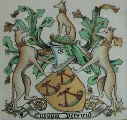|
Many people have the mistaken belief that if you have the same name as a Clan then you can use the Symbol, Crest etc. that identifies that clan. This in fact is not true, the Crest/Symbol belongs to the Head of the Clan that it has been registered to, for the sake of clarification I have reproduced an article published in "Practical Family History" in issue No. 50 (Feb 2002). This article makes it very clear that you may not use such items without the express permission of the Clan Chief/Laird to whom it is registered.
This is true of the Clan Hunter Crests, these can only be used by Clan Hunter Members, and only then with the express permission of Madam Pauline Hunter of Hunterston and of that Ilk, 30th Laird.
|
|
SCOTTISH HERALDRY
Scottish Heraldry is very rigidly controlled by the Court of the Lord Lyon King of Arms, H.M. New Register House, Edinburgh EH1 3YT. Appointed by the sovereign, the Lord Lyon King of Arms is the oldest heraldic office in Britain and also responsible for all Scottish state and ceremonial matters. As a judge he has powers of imprisonment and fines which are unique to the office. The number of subordinate officers of arms has varied over the years and is presently six. They are: Albany Herald of Arms, Rothesay Herald of Arms, Ross Herald of Arms, Orknew Herald of Arms, Unicorn Pursuivant of Arms and Carrick Pursuivant of Arms. Occasional “extraordinary” appointments of supernumerary heralds are made. The Scottish heralds are all members of the Royal Household of Scotland and charge professional fees for their heraldic and genealogical work. Unlike the College of Arms in London the Court of Lord King – often termed the Lyon Court – still has legal powers to charge, try and fine anyone who usurps some else’s arms or invents unregistered bogus arms.
One Holder
In Scotland arms belong to the individual granted them and to no one else. They can only be inherited by the direct heir mail, the direct heir female or the heir tailzie (a nominated blood relation) rather like a peerage. Any younger sons, known as cadets, have no right to their father’s arms and must petition the Lyon King of Arms for “differenced” versions. The process is called “re-matriculation” – by the minor addition of other marks or devices to their father’s arms and then registered in the Lyon Court. In large families this will result in many versions of the original arms, each with distinctive differences, and means there is no such thing as a Scottish “family coat of arms”. Nor are there “clan coats of arms”, which any clan member may use. These belong solely to the Clan Chief. However clan members have the right to wear the crest from the chief’s arms in the form of a badge surrounded by a belt and buckle, usually containing the chief’s heraldic motto.
There was evidence of heraldic activity in Scotland in the 12th century, but the very early documentation is poor and confined mainly to armorial rolls from the 14th century. Heralds’ visitations were not customary in Scotland. In 1672, under an act passed by the Scottish Parliament, the “Public Register of All Arms and Bearings of Scotland” was set up. Often termed the “Lyon Register”, unless arms are registered in it they are illegal. Registration of existing arms was free for five years until 1677, when fees were introduced and still apply today for new grants. The Lyon Register is a public document and the offices of the Lord Lyon King of Arms are open daily on weekdays for the public to inspect specified entries on payment of fees. Details of these arms are also listed in An Ordinary of Arms contained in the Public Register of All Arms and Bearings 1672-1902, by Sir James Balfour Paul and continued as a second volume covering 1903-1973, by David Reid and Vivien Wilson.
|
